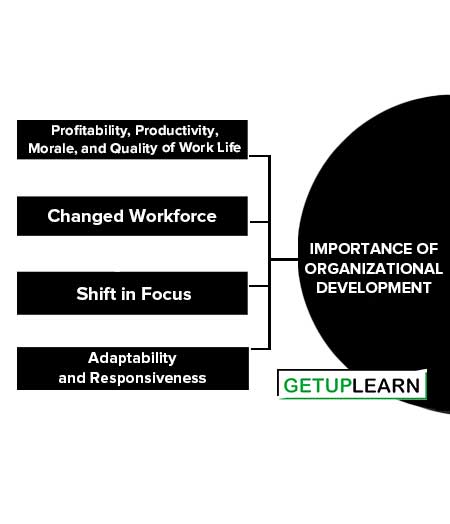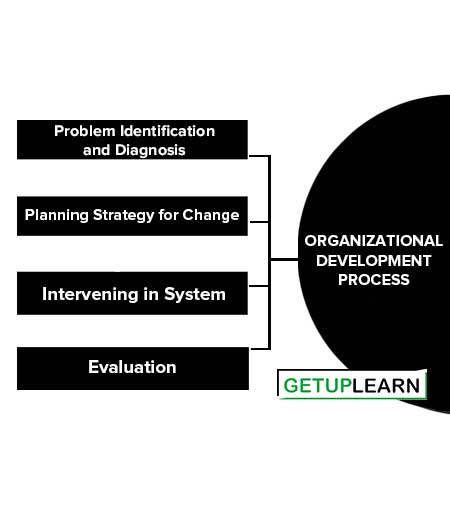Table of Contents
What is Organizational Development?
Organization Development (OD) refers to the wide range of strategies for organizational improvement. It is the process of improving organizations. The process of Organizational development is carefully planned and implemented to benefit the organization, its employees, and its stakeholders.
The term “Organization Development” is often used interchangeably with Organizational effectiveness. Organizational development is a systematic approach to improving efficiency, effectiveness, and productivity in organizations.
It is different from Human resource development in the sense that while Human resource development concerns itself with the development and training of the human beings in the organizations, Organization development is occupied with the development and improvement of organizational processes that ultimately contributes to efficiency. It is a planned, organization-wide effort to increase an organization’s effectiveness and viability.
Definition of Organizational Development
These are the definitions of organizational development given below:
Organizational development is a long term effort to improve an organization’s problem solving and renewal processes, particularly through a more effective and collaborative management of organization culture- with special emphasis on the culture of formal work teams.
Getuplearn
Organizational development encompasses a collection of planned change interventions built on humanistic democratic values that seek to improve organizational effectiveness and employee well being.
Getuplearn
A response to change, a complex educational strategy intended to change the beliefs, attitudes, values, and structure of organization so that they can better adapt to new technologies, marketing and challenges, and the dizzying rate of change itself.
Warren Bennis
Features of Organizational Development
These are the nature or features of organizational development:
- Planned Change
- Comprehensive Change
- OD Focuses on Culture and Processes
- Long-Range Change
- Dynamic Process
- Emphasis on Intervention and Action Research

Planned Change
OD is a strategy of planned change for organizational improvement.
Comprehensive Change
OD efforts focus on comprehensive change in the organization, rather than focusing attention on individuals, so that change is easily absorbed. The concept of comprehensive change is based on the systems concept- open, dynamic, and adaptive system.
OD Focuses on Culture and Processes
It specifically encourages collaboration between organization leaders and members in managing culture and processes.
Long-Range Change
OD focuses on raising an organization to a higher level of functioning by improving the performance and satisfaction of organizational members on a long-term basis.
Dynamic Process
OD is a dynamic process and includes the efforts to guide and direct changes as well as to cope with or adapt to changes imposed. It recognizes that the goals of an organization change, so the methods of attaining these goals should also change.
Emphasis on Intervention and Action Research
OD approach results in an active intervention in the ongoing activities of the organization. Action research is the basis for such intervention.
- OD focuses on total system change and views organizations as complex social systems.
- OD takes a development view that seeks the betterment of both individuals and the organization.
- OD is an interdisciplinary and primarily behavioral science approach that draws from such fields as organizational behavior, management, business, psychology, sociology, anthropology, economics, education, counseling, and public administration.
- A primary, though the not exclusive, goal of OD is to improve organizational effectiveness.
- OD recognizes the importance of top management’s commitment, support, and involvement. It also affirms a bottom-up approach when the culture of the organization supports such efforts to improve an organization.
- It is an education-based program designed to develop values, attitudes, norms, and management practices that result in a healthy organizational climate that rewards healthy behavior.
- OD is driven by humanistic values.
- It is a data-based approach to understanding and diagnosing organizations.
- . It is guided by a change agent, change team, or line management whose primary role is that of facilitator, teacher, and coach rather than subject matter expert.
- It recognizes the need for planned follow-up to maintain changes.
- It involves planned interventions and improvements in an organization’s processes and structures and requires skills in working with individuals, groups, and whole organizations.
Importance of Organizational Development
The importance of organizational development is:
- Profitability, Productivity, Morale, and Quality of Work Life
- Changed Workforce
- Shift in Focus
- Adaptability and Responsiveness

Profitability, Productivity, Morale, and Quality of Work Life
OD is a concern to most organizations because it impacts the achievement of organizational goals. There is an increasing trend to maximize an organization’s investment in its employees. Jobs that previously required physical skills; now require more mental effort. Organizations need to “work smarter” and apply creative ideas.
Changed Workforce
The workforce has also changed. Employees expect more from a day’s work than simply a day’s pay. They want a challenge, recognition, a sense of accomplishment, worthwhile tasks, and meaningful relationships with their managers and co-workers. If these needs are not met, the performance of the employees declines.
Shift in Focus
Today’s customers demand continually improving quality, rapid product or service delivery; fast turn-around time on changes, competitive pricing, and other features that are best achieved in complex environments by innovative organizational practices.
Adaptability and Responsiveness
An effective organization must be able to meet today’s and tomorrow’s challenges. Adaptability and responsiveness are essential to survive and thrive.
Organizational Development Process
OD is a process of changing people and other related aspects of an organization. Thus, it consists of many sub-processes or steps. As such uniformity in the steps involved cannot be expected. Different scholars and practitioners have defined the process of OD in different steps.
The difference in the various steps is due to defining the scope of a particular step. Moreover, since OD is an ongoing process- many of the events overlap, and in real practice, a clear-cut differentiation between various events becomes difficult. Below are given steps relevant to the OD program followed by various organizations:

Problem Identification and Diagnosis
OD attempts to solve some organizational problems. The problem may be a gap between the desired path of action and the actual path of action that the organization fails to meet its objective on a long-term basis. OD program starts with the identification of the problems in the organization.
Analysis of various symptoms both open and hidden may help in identifying the problems. The diagnosis gives correct identification of the problem and its causes and determines the scope of future problems. This involves a number of techniques concerned with identifying issues, establishing priorities, and translating them into aims and objectives.
This stage mainly comprises data collection and analysis. Problem identification is followed by a diagnosis of the problem.
Planning Strategy for Change
After the problems are carefully diagnosed, the OD practitioner either the management or consultant, plans the various courses of action in OD.
The consultant then makes attempts to transform the diagnosis of the problem into a proper action plan involving the overall goals for change, the determination of the basic approach for attaining these goals, and the sequence of detailed schemes for implementing the approach. Planning and implementation of change are independent. It is difficult to influence people to change.
Intervening in System
Intervening in the system refers to the implementation of the planned activities during the course of action. These planned activities bring certain changes in the system which is the basic objective of OD. Interventions are actions taken to produce desired changes.
To support the new vision of the organization, these actions are taken to build necessary structures, processes, and culture which are called Interventions.
In other words, OD interventions refer to various activities that a consultant performs to improve organizational performance. OD interventions are also referred to as OD techniques or OD strategies as they are designed to accomplish certain specific objectives. Various methods of intervening in the system are education, laboratory training, process consulting, team development, etc.
Evaluation
The last step in the Organizational development process is to evaluate the results of the OD program so that suitable actions may be followed up. Evaluation represents assessing the effects of the program: Was it successful? What changes occurred? Are we satisfied with the results?
OD is a long-run process; therefore, it is necessary for the consultant or management to carefully monitor and get précised feedback regarding what is going on as soon as the OD program starts and ends. In this respect, the uses of pre- and post-training behavioral patterns are quite effective. This step again involves data gathering because such data will provide the basis for OD efforts evaluation and suggest suitable modification and continuation of OD in a similar direction.
Need of Organisational Development
The field of OD is extremely broad. OD can be applied at any time, whenever an organization wants to make planned improvements using the OD values. OD might be used in any of the following situations:
- To develop or enhance the organization’s mission statement (statement of purpose) or vision statement for what it wants to be.
- To help align functional structures in an organization so they are working together for a common purpose.
- To create a strategic plan for how the organization is going to make decisions about its future and achieving that future.
- To manage conflict that exists among individuals, groups, functions, sites, and so on, when such conflicts disorder the ability of the organization to function in a healthy way.
- To put in place processes that will help improve the ongoing operations of the organization on a continuous basis.
- To create a collaborative environment that helps the organization be more effective and efficient.
- To create reward systems that are compatible with the goals of the organization.
- To assist in the development of policies and procedures that will improve the ongoing operation of the organization.
- To assess the working environment, to identify strengths on which to build and areas in which change and improvement are needed.
- To provide help and support for employees, especially those in senior positions, who need an opportunity to be coached in how to do their jobs better.
- To assist in creating systems for providing feedback on individual performance and, on occasion, conducting studies to give individuals feedback and coaching to help them in their individual development.
FAQs Section
What is the meaning of organization development?
Organizational development encompasses a collection of planned change interventions built on humanistic democratic values that seek to improve organizational effectiveness and employee well-being.
What is the simple definition of organizational development?
Organizational development is a long-term effort to improve an organization’s problem-solving and renewal processes, particularly through a more effective and collaborative management of organizational culture- with special emphasis on the culture of formal work teams. BY Getuplearn
What are the features of organizational development?
The following are the features of organizational development:
1. Planned Change
2. Comprehensive Change
3. OD Focuses on Culture and Processes
4. Long-Range Change
5. Dynamic Process
6. Emphasis on Intervention and Action Research.
What is the organizational development process?
Problem Identification and Diagnosis, Planning Strategy for Change, Intervening in System, and Evaluation are the organizational development process.
